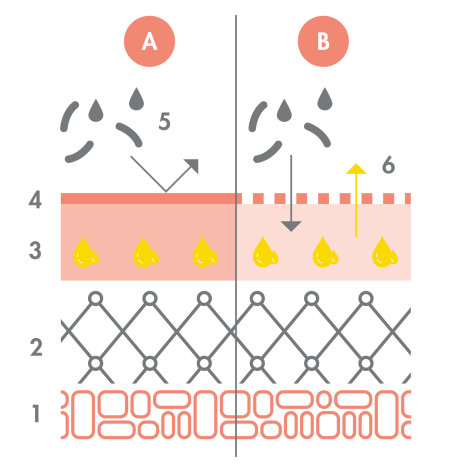Why nourish dry skin?
Unlike dehydrated skin, which lacks water, dry skin is skin that lacks lipids, in other words fatty substances. The hydrolipidic film no longer plays its role and water evaporates more easily. It is therefore essential to nourish your skin to restore suppleness and radiance. We’re here to explain everything to you.

The clear signs of oily skin
When your skin is hungry, you can feel it. Your skin is always tight, itchy, you don't feel good about yourself (so to speak).
But that can also be seen: the skin tends to display darters in winter, you know, these little round, slightly pink dry patches.
It also looks "wrinkled", red patches may appear during the day, the skin is thinner, it may peel, your complexion looks dull...
This is your reason why it's all about giving your skin what it needs.
Learn more about the signs of dry skin
I feel that my skin is getting tighter and tighter and before I get to the point of scratching I prefer to put on some cream to moisturize it.
Dry skin, a barrier to be reinforced
Dry skin is weakened skin that lacks lipids. What does it mean in concrete terms?
Our epidermis could be compared to a wall.
In this wall, our cells are the bricks and lipids mixed with an intercellular cement in a way. They ensure cells cohesion. They help maintain the skin's barrier, limit water loss, help fight against external aggressions...
You have understood that if this cement is missing, the skin is more porous and less protected.
This is why you should not simply moisturize but nourish your skin when you suffer from dryness.

How to deeply nourish dry skin
Do you think that your skin is deeply nourished by the application of rich skincare? This is true, but not only that.
Essential cleaning
Nutrition begins well before cleansing. Choose soap-free, ultra-rich products or lipid-replenishing cleansing gels that, like their name, help restore the right level of lipids to your skin while cleansing it without irritating it.
Protect and nourish
Then only, you will have the opportunity to step into the next step: nourish and protect. To do this, turn to nutritive or lipid-replenishing products. Objective: strengthens the skin's barrier and maintains a good level of hydration. A tip, apply your skincare products morning and evening. The night is the ideal moment when the skin renews and regenerates itself.
FRIENDLY (AND EXPERT) ADVICE
If you have particularly dry skin, and therefore particularly undernourished, a treatment in thick cream can be the solution.
Major remedies for major problems. In the case of particularly dry skin, a nutrient treatment is necessary. Whether for your face, your hands or your legs, a cold cream treatment will act intensely.
Quick tip: these products are ideal for very dry areas often wrinkled: heels, elbows, cuticles, etc. or to protect from the winter cold.

Nourish your skin from the inside
Adopting a balanced diet also contributes to healthy skin:
- Drink 1.5l of water every day. Our body (and a significant part of the epidermis) is in fact made up of 70% water
- To combat environmental damage, opt for the antioxidants provided by the fruit and vegetables
- Vitamin B5 helps restore the skins barrier. You will find them in some mushrooms (like shiitaké), eggs or muesli
- Vitamin A also contributes to skin health. Dairy products, egg yolk and also fish are very good sources.
Our solutions for dry skin
Eau Thermale Avène skin care products designed to protect your skin
- Revitalizing nourishing cream
Les Essentiels
Revitalizing nourishing creamNourishes - Soothes - Protects
NEWSLETTER
We're always here for your skin!
All our tips on how to take care of your skin every day.

Which skin care routine should you adopt?
Identify what it really needs with the help of our experts and discover the most suitable skin care routine for you.



